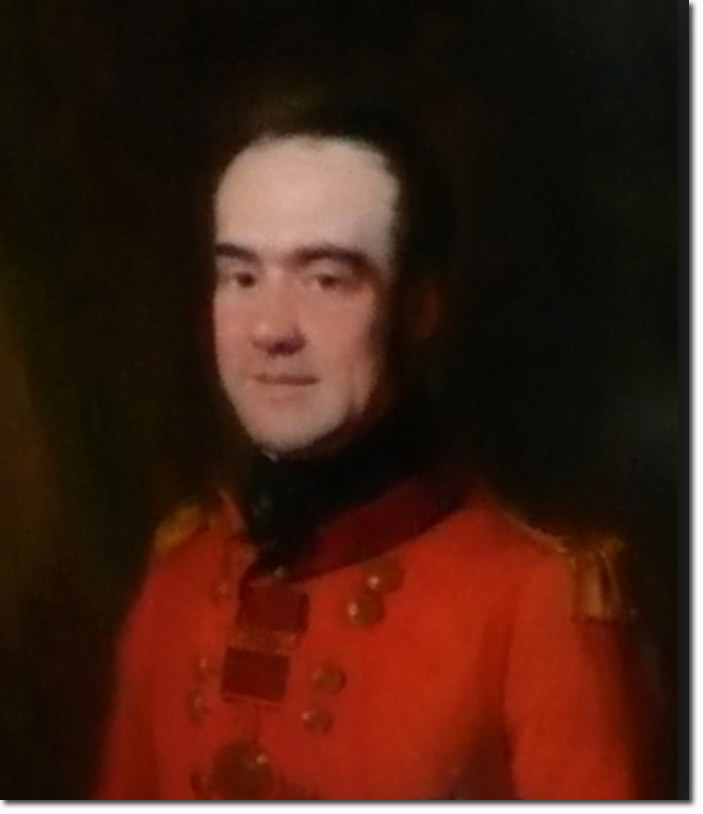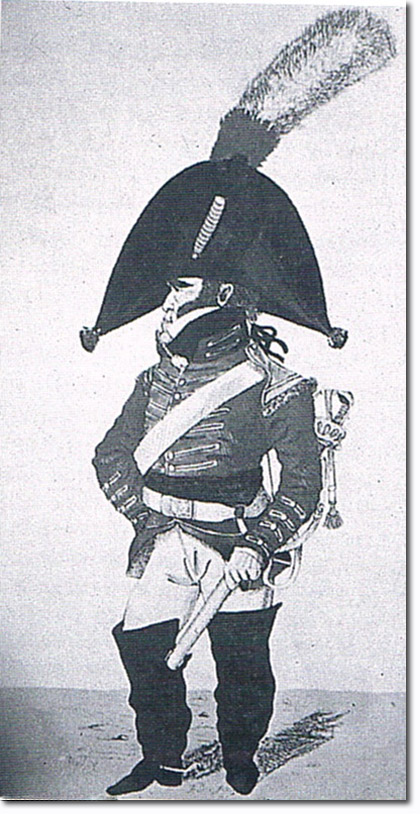|
|


|
|
John ‘Black Jack’ Slade was born on 31 Dec 1762, the son of John Slade and Charlotte Portal of Maunsel House, Somerset. He lived to a great age, dying on 13 Aug 1859 at the age of 97. He was married twice, to Anna Eliza Dawson (d 1819) and Matilda Ellen Dawson (not related) and had 15 children including Vice-Admiral Sir Adolphus Slade, Lt-General Sir Marcus John Slade, Major-General Herbert Dawson Slade, two lieut-colonels, a major and a reverend.
Sir John Slade is famous for his ineptitude as a cavalry commander and for his unpopularity with his officers and men. He earned the nickname Black Jack during the Peninsula War in which he commanded cavalry brigades from 1808 to 1813. In 1780 he was commissioned, at the age of 17 into the 10th Dragoons. His progress to the rank of general was as follows: 1780 Cornet 10th Dragoons, 11 May 1783 Lieutenant 10th (later Light Dragoons), 28 April 1787 Captain 10th Light Dragoons, 24 Oct 1794 Major 10th Light Dragoons, 1 Mar 1795 Lieutenant-Colonel 10th Light Dragoons,29 Apr 1798 Exchanged to command 1st Royal Dragoons 1800 Equerry to Duke of Cumberland 1802 Colonel in the Army, 29 April 1804 Brigadier. Relinquished command of 1st RD. 1808 Commanded Hussar Brigade in Peninsula 1809 Fought at Corunna as a volunteer 1809 Returned to the Peninsula commanding a brigade of dragoons 1809 Major-General, 25 Oct 1813 Served in Ireland 1814 Lieutenant-General, 4 June 1831 Colonel of 5th Dragoon Guards, 20 July 1831 Elevated to 1st Baronet, 30 Sep 1835 Appointed Knight Grand Cross of the Royal Guelphic Order (GCH) 1837 General, 10 Jan 1859 Died 13 August at Montys Court, Somerset John Slade had reached the position of 2nd in command of the 10th Light Dragoons before he exchanged to the Royals in 1798. He was a close friend of the Prince of Wales, and when the Hussar Brigade embarked at Portsmouth on 18 Oct 1808, the Prince took off his sash and gave it to Slade, commander of the brigade, along with his hussar jacket and pelisse. Presumably this was because Slade was now a heavy dragoon and did not have a suitable uniform to lead hussars. The initial foray into the Peninsula ended with the winter retreat to Corunna, but before that the hussars fought at Sahagun, Mayorga and Benevente. They distinguished themselves despite their inept brigadier. Captain Gordon of the 15th Hussars wrote in his diary: ‘Dec 17th. We marched this day to Villa Graxima, which by the direct road is only three leagues from La Motta, but General Slade with his wonted sagacity contrived to find a route which increased the distance by two leagues….We had great reason on this occasion to lament the want of enterprise displayed by our worthy brigadier and total neglect of all means to procure information: it was an unfortunate circumstance that he had chosen to attach himself to the 15th for if he had remained with the 10th I have little doubt that Colonel Grant (of the 15th) would have given us an opportunity of proving our mettle.’ The action at Sahagun was one of the 15th Hussars’ great achievements thanks to the fact that Slade was at that time with the 10th. If Slade’s men had attacked the convent there as planned the retreating French would not have escaped but the ‘dilatory proceedings of the Brigadier’ scuppered the 10th’s chances of sharing the glory. He held them up by making a long speech concluding with the exhortation “Blood and Slaughter! March!” At Mayorga, Captain Gordon, again, was an eye witness to the action: ‘Two squadrons of Chasseurs a Cheval were discovered on rising ground about a mile distant. Lord Paget directed General Slade to attack them with a squadron of the 10th supported by the the remainder of the regiment. The General moved off at a trot, but had not advanced far when he halted to have some alterations made to the length of his stirrups. An aide-de-camp was sent to enquire the cause of the delay and the squadron was again put in motion, but the General’s stirrups were not adjusted to his mind and he halted again before they had advanced a hundred yards. Lord Paget, whose patience was this time quite exhausted, then ordered Colonel Leigh to take the lead. The 10th charged gallantly, routed the enemy and took between 40 and 50 prisoners with little loss on their part.’ When the army resumed operations in the Peninsula after the retreat from Corunna, Slade commanded heavy dragoons but his bad leadership of cavalry was confirmed at the battle of Maguilla where after a long pursuit they fell into a French trap. The Royals and 3rd Dragoon Guards panicked and fled from the French counter-attack. Slade was seen galloping about offering 50 pounds to any man who would stand and fight but to no avail, and the British, in their turn were pursued for several miles, losing 22 killed, 26 wounded, and 120 taken prisoner. Wellington was furious and the whole affair brought the cavalry generally into disrepute. Wellington accused the cavalry of ‘Galloping at everything’ and never again trusted them to ‘keep back or provide for a reserve’. This view was proved correct at Waterloo where the cavalry lost control and galloped too far. Wellington contrived to have Slade removed from the Peninsula and sent home to serve in Ireland. This did not end his chances of promotion or his rewards which included a baronetcy and the thanks of Parliament. He reached the rank of full General and lived well into the 19th century dying at home on 13 Aug 1859. He lived at Montys Court and was buried at Norton Fitzwarren, Taunton, Somerset. The coloured portrait of John Slade c1816 makes him look rather simple, and the caricature (below) of him by Robert Dighton was painted around 1801, showing him in profile, wearing the uniform of the Royal Dragoons which he commanded at that time. Dighton makes him look short and stocky. |

|
Armed Forces | Art and Culture | Articles | Biographies | Colonies | Discussion | Glossary | Home | Library | Links | Map Room | Sources and Media | Science and Technology | Search | Student Zone | Timelines | TV & Film | Wargames